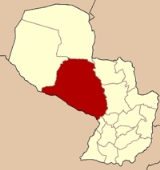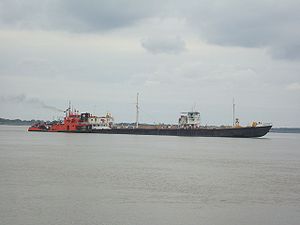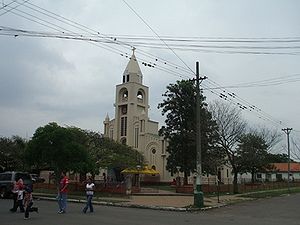
Presidente Hayes Department
Encyclopedia
Presidente Hayes is a department
in Paraguay
. The capital is the city of Villa Hayes
. The department was named after U.S. President Rutherford B. Hayes
, who was the arbitrator in a boundary dispute between Paraguay and Argentina
after the War of the Triple Alliance
.
Only Fort Borbon
, today called Fort Olimpo
, survived. Founded during the government of Alos and Bru, the garrison contained the southern advance of the Portuguese
.
French settlers tried but failed to settle the area, with the exception of “Villa Occidental”.
It was named Presidente Hayes after the War against the Triple Alliance
, in honor of the United States president Rutherford B. Hayes
, whose intervention resulted in Paraguay retaining the territory.
In 1906, during the political division of Paraguay, it was split in two regions, Oriental and Occidental. The latter was divided in military headquarters that depended on the War and Marine Ministry.
Important dates for this department include June 12 (Chaco Peace Day), September 29 (Boquerón Victory Day) and November 12 (Laudo Hayes Firm Day).

The hills Confuso, Siete Cabezas and Galván are small elevations.
The Tinfunqué National Park is a major tourist attraction; it has an area of 280,000 hectares.
In Presidente Hayes floods are frequent because of the overflow of the rivers, but just in Villa Hayes
city, the land in other parts of the department is higher.
None of the rivers that part from Paraguay River are navigable for big ships.

The deviation of the Pilcomayo River towards Argentina has produced several changes in the habits of the people; the drought causes the migration of the jacarés to most humid areas, and also the spreading of diseases.
Some species of plants in danger are: timbó, samu’u, white and red quebracho and karanday. Among the animal species in danger are: carpincho, jurumi, jacaré and tapir.
, and second in production of horses.
The population is heavily involved in agriculture; the department is third place in production of sorghum
. Cotton
and sweet cane
are also agricultural products of the area.
Villa Hayes and Benjamín Aceval
are noticeable for the production of sweet cane.
In Villa Hayes are the sugar factory Censi and Pirota. Sawmill
s, ceramic
factories and steel
mills are also in the city. ACEPAR, Aceros del Paraguay, is an important iron and steel industry and is also located in Villa Hayes.
In addition, in Villa Hayes is Astillero Chaco Paraguayo S.A., a specialising in the construction of launches for heavy loads, fuel and vegetable oil transportation. There is also soap and lime factories and an ESSO
plant of fuel and lubricants.
Puerto Falcón is an area of very intense economic trading with Argentina and has heavy tourism.

.
The Route No. 12 “Vice Presidente Sánchez” borders Pilcomayo River, but is not passable when raining.
The road Pozo Colorado-Puerto Milirar, reaches Concepción, crossing the Paraguay River through a bridge.
The different roads that connect portions of the department have the inconvenience of being impassable during the rainy season.
Paraguay River is the most used way to communicate with Puerto Pinasco.
In Puerto Falcón, is possible the communication with the Argentine city Clorinda
through the San Ignacio de Loyola International Bridge.
The cattle establishments use aerial ways.
The department has two radio stations in FM, Radio Villa Hayes and Dyon. About 3,200 people count with phone service.
There are 16,865 households in the department, 6,165 in the urban area and 10,700 in the rural area. The percentage of which count with basic facilities are the following:
There are 38 health establishments, counting hospital and health care centers.
Department (subnational entity)
Department is the name given to the administrative and political subdivisions of many countries.As a territorial unit, "department" was first used by the French Revolutionary governments, apparently to emphasize that each territory was simply an administrative sub-division of the united sovereign...
in Paraguay
Paraguay
Paraguay , officially the Republic of Paraguay , is a landlocked country in South America. It is bordered by Argentina to the south and southwest, Brazil to the east and northeast, and Bolivia to the northwest. Paraguay lies on both banks of the Paraguay River, which runs through the center of the...
. The capital is the city of Villa Hayes
Villa Hayes
Villa Hayes is a city in Paraguay, and is the capital of the department of Presidente Hayes.-Name:Known as “the City of the Five Names”, it was eventually named in honor of Rutherford B. Hayes, 19th President of the United States.-Weather:...
. The department was named after U.S. President Rutherford B. Hayes
Rutherford B. Hayes
Rutherford Birchard Hayes was the 19th President of the United States . As president, he oversaw the end of Reconstruction and the United States' entry into the Second Industrial Revolution...
, who was the arbitrator in a boundary dispute between Paraguay and Argentina
Argentina
Argentina , officially the Argentine Republic , is the second largest country in South America by land area, after Brazil. It is constituted as a federation of 23 provinces and an autonomous city, Buenos Aires...
after the War of the Triple Alliance
War of the Triple Alliance
The Paraguayan War , also known as War of the Triple Alliance , was a military conflict in South America fought from 1864 to 1870 between Paraguay and the Triple Alliance of Argentina, Brazil, and Uruguay...
.
Districts
The department is divided into 8 districts:- Benjamín AcevalBenjamín Aceval (Paraguay)Benjamín Aceval is a town in the Presidente Hayes department of Paraguay. The city is the seat of the Roman Catholic Diocese of Benjamín Aceval.-Etymology:...
- Gral. Bruguez
- Jose FalconJosé FalcónJosé Carlos Frita Falcão, known as José Falcón was a Portuguese matador whose bullfighting career spanned just over a decade...
- Nanawa (Puerto Elsa)
- Puerto Pinasco
- Teniente Esteban Martínez
- Teniente Irala Fernández
- Villa HayesVilla HayesVilla Hayes is a city in Paraguay, and is the capital of the department of Presidente Hayes.-Name:Known as “the City of the Five Names”, it was eventually named in honor of Rutherford B. Hayes, 19th President of the United States.-Weather:...
History
In the colonial period, conflicts between settlers and native tribes resulted in the abandonment of towns and missions including Melodía, Timbó, Naranajay and Remolinos.Only Fort Borbon
Fort Borbon
Fort Borbón is a fort located in the Paraguayan Chaco; it was established to provide protection from the natives and Portuguese. After the Portuguese were expelled by Gaspar Rodríguez de Francia, it was changed to its present name Fort Olimpo.-History:...
, today called Fort Olimpo
Fuerte Olimpo
Fuerte Olimpo is a city in Paraguay. It is the capital of the department of Alto Paraguay.Capital of Alto Paraguay Region, far from Asunción 838 km, located on Paraguay River, originally called Fuerte Bordón...
, survived. Founded during the government of Alos and Bru, the garrison contained the southern advance of the Portuguese
Portuguese people
The Portuguese are a nation and ethnic group native to the country of Portugal, in the west of the Iberian peninsula of south-west Europe. Their language is Portuguese, and Roman Catholicism is the predominant religion....
.
French settlers tried but failed to settle the area, with the exception of “Villa Occidental”.
It was named Presidente Hayes after the War against the Triple Alliance
War of the Triple Alliance
The Paraguayan War , also known as War of the Triple Alliance , was a military conflict in South America fought from 1864 to 1870 between Paraguay and the Triple Alliance of Argentina, Brazil, and Uruguay...
, in honor of the United States president Rutherford B. Hayes
Rutherford B. Hayes
Rutherford Birchard Hayes was the 19th President of the United States . As president, he oversaw the end of Reconstruction and the United States' entry into the Second Industrial Revolution...
, whose intervention resulted in Paraguay retaining the territory.
In 1906, during the political division of Paraguay, it was split in two regions, Oriental and Occidental. The latter was divided in military headquarters that depended on the War and Marine Ministry.
Important dates for this department include June 12 (Chaco Peace Day), September 29 (Boquerón Victory Day) and November 12 (Laudo Hayes Firm Day).
Borders
Located between parallels 22º 03’ and 25º 20’ of South latitude and the meridians 57º 15’ and 61º 00’ of longitude West.- To the North: Alto Paraguay departmentAlto Paraguay DepartmentAlto Paraguay is a sparsely populated department of Paraguay. The capital is the town of Fuerte Olimpo.In 1992 the Chaco Department was merged with Alto Paraguay, effectively recreating the original department Olimpo as it existed until 1945....
, from which is separated by the road of the railway from “km 160” to “km 20”, from this point by an imaginary straight line until Paraguay RiverParaguay RiverThe Paraguay River is a major river in south central South America, running through Brazil, Bolivia, Paraguay, and Argentina...
. - To the South: ArgentinaArgentinaArgentina , officially the Argentine Republic , is the second largest country in South America by land area, after Brazil. It is constituted as a federation of 23 provinces and an autonomous city, Buenos Aires...
, from which is separated by the Pilcomayo River, all the way from its flow into the Paraguay RiverParaguay RiverThe Paraguay River is a major river in south central South America, running through Brazil, Bolivia, Paraguay, and Argentina...
to the San Lorenzo Mission. - To the East: the departments ConcepciónConcepción Department (Paraguay)Concepción is a department of Paraguay. The capital is the city of Concepción.- History :Throughout history, this department has suffered a great amount of poblational instability, especially in the times of the colony, due to the advance of the Brazilian “bandeirantes” through the east and the...
, San Pedro, CordilleraCordillera Department-History:During the seventeenth and eighteenth centuries this area of the country was going through a serious crisis due to population bellicosity of the Indians from Chaco. The villagers from Tobatí located north of the river Pirapo then called, had to migrate south for the continue attacks by...
and CentralCentral DepartmentCentral is a department in Paraguay. The capital is Areguá. With its 1,929,834 inhabitants it is the most populated of the 17 departments of Paraguay.-Boundaries:*North: the departments of Cordillera and Presidente Hayes....
; Presidente Hayes is separated from them by the Paraguay River, from its flow into the La Paz River until the Pilcomayo River. - To the West: Boquerón departmentBoquerón DepartmentBoquerón is a department in the western region of Paraguay. It is the country's largest department, with an area of , but its population is only 45,617 . The department includes the Russian Mennonite colonies of Fernheim, Menno and its administrative center Loma Plata and Neuland. The capital is...
, separated by the road that connects the San Lorenzo Mission with the Forts Gral. Díaz, Avalos Sánchez, Zenteno, Dr. Gaspar Rodríguez de Francia, Boquerón, Isla Poí and Casanillo, and from this point with an imaginary straight line until “km 160”.

Climate
The temperature reaches 44°C in summer and drops to 0°C in winter, the average temperature is 26°C. The average amount of precipitation is about 900 and 1200 millimeters annually.Orography and soil
The type of soil can be classified in two kinds: to the east, saline soil, to the south, to Pilcomayo River, calcareous soil, to the Paraguay River.The hills Confuso, Siete Cabezas and Galván are small elevations.
Hydrography
The Paraguay River borders the entire department; the rivers Pilcomayo, San Carlos, Siete Puntas, Negro, Verde, Montelindo, Aguaray Guazú and Confuso also flow through this territory. To the south there is the Patiño Swamp.The Tinfunqué National Park is a major tourist attraction; it has an area of 280,000 hectares.
In Presidente Hayes floods are frequent because of the overflow of the rivers, but just in Villa Hayes
Villa Hayes
Villa Hayes is a city in Paraguay, and is the capital of the department of Presidente Hayes.-Name:Known as “the City of the Five Names”, it was eventually named in honor of Rutherford B. Hayes, 19th President of the United States.-Weather:...
city, the land in other parts of the department is higher.
None of the rivers that part from Paraguay River are navigable for big ships.

Natural environment
In Chaco territory can be found 4 special ecosystems: the Floodplain of the Paraguay River, Pozo Azul, Laguna Salada and the Floodplain of the Pilcomayo River.The deviation of the Pilcomayo River towards Argentina has produced several changes in the habits of the people; the drought causes the migration of the jacarés to most humid areas, and also the spreading of diseases.
Some species of plants in danger are: timbó, samu’u, white and red quebracho and karanday. Among the animal species in danger are: carpincho, jurumi, jacaré and tapir.
Economy
Presidente Hayes has the first place in production of cattleCattle
Cattle are the most common type of large domesticated ungulates. They are a prominent modern member of the subfamily Bovinae, are the most widespread species of the genus Bos, and are most commonly classified collectively as Bos primigenius...
, and second in production of horses.
The population is heavily involved in agriculture; the department is third place in production of sorghum
Sorghum
Sorghum is a genus of numerous species of grasses, one of which is raised for grain and many of which are used as fodder plants either cultivated or as part of pasture. The plants are cultivated in warmer climates worldwide. Species are native to tropical and subtropical regions of all continents...
. Cotton
Cotton
Cotton is a soft, fluffy staple fiber that grows in a boll, or protective capsule, around the seeds of cotton plants of the genus Gossypium. The fiber is almost pure cellulose. The botanical purpose of cotton fiber is to aid in seed dispersal....
and sweet cane
Cane
Cane are either of two genera of tall, perennial grasses with flexible, woody stalks from the family Poaceae that grow throughout the world in wet soils. They are related to and may include species of bamboo. The genus Arundo is native from the Mediterranean region to the Far East. Arundinaria...
are also agricultural products of the area.
Villa Hayes and Benjamín Aceval
Benjamín Aceval (Paraguay)
Benjamín Aceval is a town in the Presidente Hayes department of Paraguay. The city is the seat of the Roman Catholic Diocese of Benjamín Aceval.-Etymology:...
are noticeable for the production of sweet cane.
In Villa Hayes are the sugar factory Censi and Pirota. Sawmill
Sawmill
A sawmill is a facility where logs are cut into boards.-Sawmill process:A sawmill's basic operation is much like those of hundreds of years ago; a log enters on one end and dimensional lumber exits on the other end....
s, ceramic
Ceramic
A ceramic is an inorganic, nonmetallic solid prepared by the action of heat and subsequent cooling. Ceramic materials may have a crystalline or partly crystalline structure, or may be amorphous...
factories and steel
Steel
Steel is an alloy that consists mostly of iron and has a carbon content between 0.2% and 2.1% by weight, depending on the grade. Carbon is the most common alloying material for iron, but various other alloying elements are used, such as manganese, chromium, vanadium, and tungsten...
mills are also in the city. ACEPAR, Aceros del Paraguay, is an important iron and steel industry and is also located in Villa Hayes.
In addition, in Villa Hayes is Astillero Chaco Paraguayo S.A., a specialising in the construction of launches for heavy loads, fuel and vegetable oil transportation. There is also soap and lime factories and an ESSO
ESSO
ESSO may refer to:*Esso, a brand name of products marketed by Exxon Mobil*Enterprise single sign-on*Estonian State Symphony Orchestra or Estonian National Symphony Orchestra, an orchestra in Tallinn, Estonia, also known as ERSO *Esso , a rural locality in Bystrinsky District of...
plant of fuel and lubricants.
Puerto Falcón is an area of very intense economic trading with Argentina and has heavy tourism.

Transportation and services
The most important way of transportation is Route No. 9 “Carlos Antonio López” also known as “Transchaco”, which cross the Paraguay River through the Remanso Bridge and extends to BoliviaBolivia
Bolivia officially known as Plurinational State of Bolivia , is a landlocked country in central South America. It is the poorest country in South America...
.
The Route No. 12 “Vice Presidente Sánchez” borders Pilcomayo River, but is not passable when raining.
The road Pozo Colorado-Puerto Milirar, reaches Concepción, crossing the Paraguay River through a bridge.
The different roads that connect portions of the department have the inconvenience of being impassable during the rainy season.
Paraguay River is the most used way to communicate with Puerto Pinasco.
In Puerto Falcón, is possible the communication with the Argentine city Clorinda
Clorinda, Formosa
Clorinda is a city in the province of Formosa, Argentina. It is the head town of the Pilcomayo Department, and has 47,240 inhabitants as per the . It is located 115 km north-northeast from the provincial capital Formosa, at the easternmost tip of the province, 4 km from the Paraguayan border, on...
through the San Ignacio de Loyola International Bridge.
The cattle establishments use aerial ways.
The department has two radio stations in FM, Radio Villa Hayes and Dyon. About 3,200 people count with phone service.
There are 16,865 households in the department, 6,165 in the urban area and 10,700 in the rural area. The percentage of which count with basic facilities are the following:
- Electric power: 39.9%
- Running water: 19.1%
- Trash collection: 4.3%
Health and education
The region has 96 institutions of elementary education, 192 of basic education and 29 of high school education.There are 38 health establishments, counting hospital and health care centers.
See also
- List of high schools in Presidente Hayes

